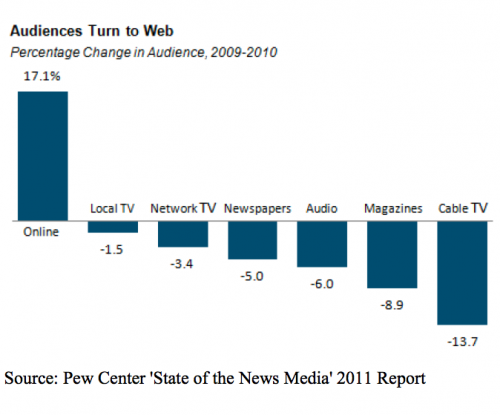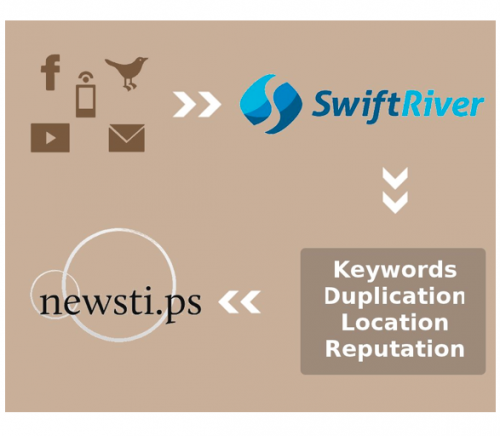[Guest blog post by Jenka Soderberg, a 2011 Knight Fellow at Stanford University and Evening News Director at KBOO Community Radio in Portland, Oregon. She can be reached at jenka [at] stanford [dot] edu].
When I first started working on www.Indymedia.org in 2000, I was really excited about the platform it provided: a way for people who witnessed news events to immediately publish text, audio, video and photos to an OPEN newswire. This was unprecedented on the web at that time, and led to an explosion of open multimedia content-posting sites. Since its inception at the World Trade Organization protests in Seattle in 1999, the Independent Media Center expanded into over 200 local sites worldwide, all funneling featured content into the main (global) site www.indymedia.org. In many ways, this could represent the way news organizations operate in the future – but most of the major news companies haven't caught on to this trend just yet.
I got into the world of journalism because I didn't trust the media. Time and again, I'd read, hear or watch news stories that were grossly inaccurate, one-sided and oversimplified. So I took seriously the slogan, “Don't hate the media, BE the media”, and helped launch a bunch of indymedia centers and microradio stations all over the world, always with the hope of giving voice to the voiceless, allowing people to tell their own stories and to share in the narrative that was developing about them without the often-damaging involvement of advertising dollars and managing editors who presume to dumb things down for audiences they believe they have to entertain as well as inform.
Now, with more and more people turning away from traditional media to get their news online (see chart), it seems those audiences, about whom so many assumptions were made by the management of media corporations, are trying to find their own way in the new media world and find the news that they think is important and valuable.
Unfortunately, this often means that people seek out only news sources that confirm and uphold their existing points of view, and may be just as full of inaccuracies, speculation and oversimplification as the news media that they were trying to escape.
How can we get through the mess of misinformation to find the real tips of breaking news events, as they're happening, and get this information out to as broad an audience as possible?
I've been working with a team at Stanford this year to use Ushahidi's Swiftriver platform, and specifically Sweeper (one of the multiple tools in the Swiftriver toolbox) to try to extract real newstips from the deluge of 140-character texts and tweets, and try to figure out which newstips are real and accurate. Our project description and current newswire is at www.newsti.ps
We're implementing this in the Occupied Palestinian Territories, an area where many news incidents are under-reported in the US, and others are over-reported, giving US audiences a skewed perspective of the reality on the ground. We're using the Swiftriver platform to skim the web and twitter for keywords that are then filtered by keyword, location, reputation and duplication and organized into a database. Our reporters in different parts of the Palestinian Territories (the West Bank, Gaza and Jerusalem), can follow up on the most poignant of these tips and verify their accuracy. These reporters have created the International Middle East Media Center (www.imemc.org), currently the most widely-read English-language news site based in the Palestinian Territories.
We're also working on a way to allow people who witness news events but don't have the luxury of a smart phone yet (only 2% of cellphone users in the Palestinian Territories have smart phones, and 3G is extremely spotty), to send texts and photos directly into our system as well. For translation of Arabic texts, we've solicited the help of the crowdsourced translation team of www.meedan.net.
Like with Indymedia, we think that this work can be an alternative to the mainstream media – although, as always, they are free to use these news stories, it seems unlikely that many will. When news corporations are focused on selling advertising dollars instead of providing accurate news for their audiences, they will continue to go the way of the dinosaurs, as they are doing. Unfortunately what we're losing right now are lots of good, investigative news reporters who held politicians' feet to the fire, reported on breaking news events and local issues, investigated wrongdoing by large companies, connected audience members with the stories of people in different circumstances far across the globe, but with whom they could relate due to the strength of the writing and storytelling. What we're left with right now, to a large extent, are cable news channels whose focus is on entertainment and advertising, and vitriolic talk radio that exuberantly embraces speculation, rumor and misinformation over fact-checked, accurate news reports. On the local news front, AOL's newest branchild, patch.com, threatens to replace real local reporting with half-hearted, badly-written reports that are unapologetically inaccurate.
Can we get a 'people's newswire' based on eyewitness reports of newsworthy events? I believe we can – if we combine the automation of systems like Swiftriver, the data visualization possibilities of tools like Ushahidi, and the insight of trained reporters who can follow up on potential leads. Heck, if we can do it in the Palestinian Territories, then we can do it anywhere!
The video below is a short presentation about this project. Be sure to check out our website www.newsti.ps for real-time updates during the upcoming humanitarian flotilla to break the siege on the Gaza Strip.


